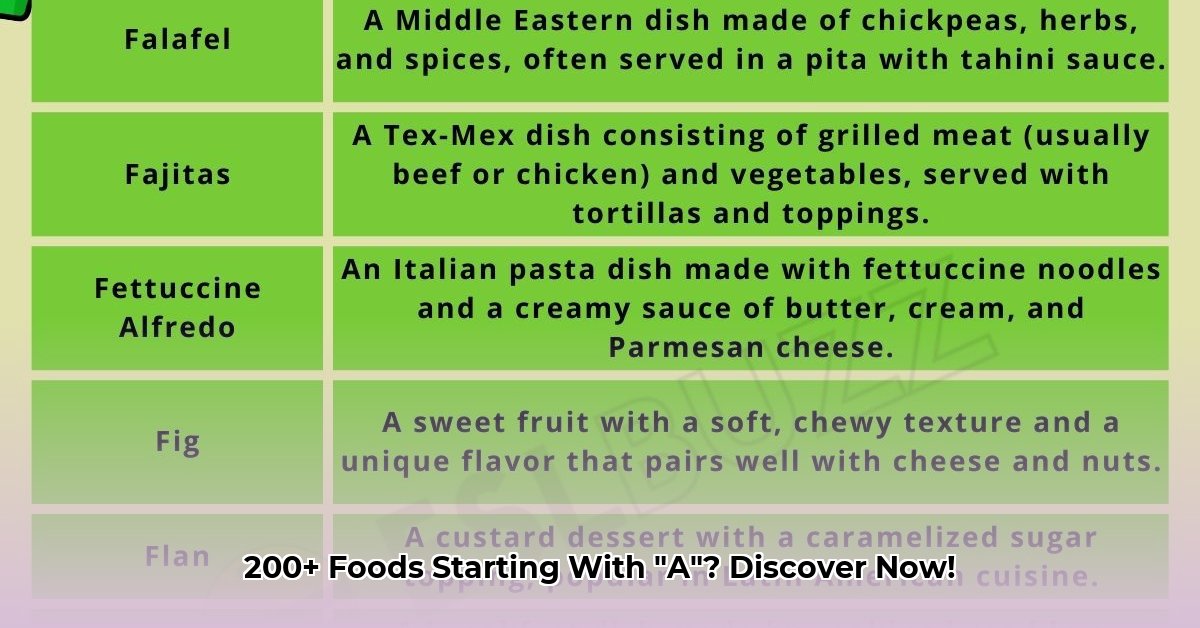Ever noticed how many yummy foods start with the letter A? From everyday apples to more exotic things like alligator pepper, it’s a surprisingly big list! This isn’t just a simple rundown; we’re diving deep into the delicious world of “A” foods from around the globe. We’ll uncover tasty treats, share cooking tips, and even sneak a peek at what the pros are doing in their kitchens. For even more “A” foods, check out this extensive list. Get ready to explore some amazing ingredients and add some exciting new dishes to your cooking lineup!
Foods That Start With A: A Global Culinary Exploration
Let’s dive into a delicious adventure exploring the incredible variety of foods beginning with the letter “A”! From everyday snacks to exotic delicacies, this culinary journey spans the globe and introduces you to a world of flavors you might not even know existed. Get ready to tantalize your taste buds with this food alphabet!
A Taste of the Americas: Popular Staples and Culinary Heritage
North America offers a bunch of “A” foods we’re all pretty familiar with. Think creamy avocados, perfect for guacamole or just sliced on toast. Apples, of course—from crisp Honeycrisps to sweet Galas, they’re versatile in pies, sauces, and even a refreshing cider. And who doesn’t love the peppery kick of arugula in a salad with balsamic vinaigrette?
But the Americas hold so much more than just these common treats. Journey south, and you’ll discover the vibrant world of South and Central American cuisine. Achiote paste, for example, adds a rich, earthy flavor to many dishes – it’s a total game-changer for latin dishes! Have you tried acai berries? These Amazonian superstars are packed with nutrients and taste amazing in smoothies. Then there are arepas, those delightful corn cakes that are a staple in many countries. Each bite is a little piece of history and culture. Don’t forget the tangy kick of Acerola cherries, packed with Vitamin C and perfect for juices.
Asian Delights: Spices, Nuts and Culinary Traditions
Asia opens up a whole treasure chest of “A” foods, many with incredible aromas and flavors. Almonds, a popular snack worldwide, are also integral to many traditional Asian sweets and savory dishes. Asparagus, a classic vegetable you might find in your local grocery store, takes on different forms and flavors in Asian cooking. Think about the delicate sweetness of certain asparagus varieties in a stir-fry.
But beyond the familiar, Asian cuisine is rich with unique “A” ingredients. Anise, with its distinct licorice-like flavor, adds a magical touch to many dishes. Artichoke hearts boast a unique, slightly nutty and earthy flavor, wonderful as an appetizer or a sophisticated addition to pasta dishes. The sheer variety is astounding! Did you know that Southeast Asia has its own variations of savory snacks, known as Acar, with each recipe unique to the region? And who can forget Adzuki beans, a staple in East Asian cuisine, often used in sweet red bean paste? From savory to sweet, Asia has it all!
European Gastronomy: Cheeses, Aspic and Baked Goods
Europe, with its lengthy culinary history, contributes a significant number of “A” foods to our list. Artisanal cheeses, such as the nutty Asiago, offer complex flavor profiles that make any cheese board truly special. Aspic, a savory meat jelly, might sound a bit unusual, but it adds a surprisingly elegant touch to certain European dishes. Then there are apricots, bursting with sunshine – perfect in jams, desserts, or enjoyed fresh. And let’s not forget aubergines (eggplants), essential ingredients in many Mediterranean recipes, giving dishes a wonderful texture and depth. Another European delight is almond croissants, a flaky and buttery pastry that is perfect for breakfast or a sweet treat.
African Flavors: Grains, Stews, and Unique Ingredients
Africa offers a diverse range of “A” foods, often featuring hearty grains and flavorful stews. Amaranth, a nutritious grain, is a staple in many African countries, providing a good source of protein and fiber. Ackee, a fruit native to Jamaica but also found in West Africa, is a key ingredient in the popular Jamaican dish, Ackee and Saltfish. Don’t miss Aish, a traditional Egyptian bread, and Agashe, a popular peanut-based snack in West Africa. Discovering African cuisine reveals a world of unique flavors and textures.
A Global Food Guide: A Delicious Lineup from Around the World
To truly appreciate the breathtaking range of “A” foods, let’s have a quick look at some of our favorites from different continents:
| Continent | Food Item | Description | Interesting Fact |
|---|---|---|---|
| North America | Avocado | Creamy fruit; versatile in guacamole, salads, and more. | Avocados are botanically a single-seed berry! |
| South America | Acai Berries | Nutrient-rich, deep purple berries from the Amazon. | Often blended into smoothies or eaten frozen. |
| Asia | Almonds | Versatile nut; used in desserts, savory dishes, and snacks. | Almonds are members of the rose family. |
| Europe | Artichoke Hearts | Unique vegetable with a slightly nutty flavor. | Requires some effort to prepare, but well worth it! |
| Africa | Amaranth | A grain used extensively in African cuisine. | A complete protein, high in fiber and minerals. |
| Australia | Aniseed Myrtle | Native Australian plant with anise-like flavor. | Used in teas, desserts, and savory dishes. |
Expand Your Palate: Embark on a Delightful Adventure
This isn’t just a list; it’s your passport to a world of culinary exploration. Each food on this list has a unique story, reflecting its origins and cultural significance. So next time you’re at the grocery store or planning that next amazing dinner party, keep in mind this incredible array of “A” foods. What tasty adventures await you? Perhaps you’ll discover a new favorite dish or ingredient. The possibilities are truly endless! Happy cooking!
How to Predict Future Food Trends Using Global Consumption Data
Key Takeaways:
- Accurate food demand forecasting is crucial for efficient resource allocation and food security. Simple extrapolations are insufficient; more complex models are needed.
- Incorporating demographic data (age, income, generation) and consumer preferences improves predictive accuracy.
- Understanding generational consumption patterns offers valuable insights for long-term planning for food businesses.
A is for Appetizing Data: Understanding Global Food Choices
Let’s embark on a delicious exploration of foods starting with the letter “A”! This culinary adventure will highlight the diversity of global cuisine while touching on how to predict future food trends using global consumption data. Imagine a world map, each pin representing a unique “A” food – from the familiar to the exotic. How do we anticipate which cuisines and ingredients will gain popularity in the coming years?
Understanding the “A” Game: Global Food Consumption Explained
The key lies in analyzing global consumption data. Think of it as a giant puzzle; each piece represents consumer choices. By meticulously piecing together these choices, we can identify emerging trends in the food industry. We combine data on purchases, restaurant orders, and social media mentions to paint a detailed picture. Different methodologies (machine learning, statistical modeling) are used to analyze this data.
Several factors influence these trends. Generational differences are significant. What one generation craves, another might shun. Economic shifts play a role, too. During economic downturns, people might switch to more affordable options. Climate change’s impact on crop yields can dramatically alter availability and pricing and consumer behaviour. The rise of plant-based diets is another key factor shaping food preferences.
A World of “A” Foods: A Culinary List for Aspiring Chefs
The following is a curated list of “A” foods, showcasing the breadth of global cuisine. Remember, understanding consumption patterns for these foods helps us predict future trends – perhaps “A” foods will become even more central to global diets.
| Food | Origin/Region | Description | Potential Future Trend (based on current data) |
|---|---|---|---|
| Artichoke | Mediterranean | A thistle-like vegetable with delectable heart. | Growing popularity in health-conscious markets. |
| Arugula | Mediterranean | Peppery, leafy green. | Continued growth in salad and gourmet dishes. |
| Avocado | Central America | Creamy fruit, high in healthy fats. | Sustained demand, potentially increased sustainability focus. |
| Apricot | Central Asia | Sweet stone fruit. | Seasonal variations, potential year-round availability gains. |
| Almonds | Middle East, Asia | Nutritious tree nut. | Increasing demand likely, driven by health trends. |
| Anchovies | Mediterranean | Small, salty fish. | Rediscovery as an umami-rich flavor enhancer. |
This table, however, is just a taste! There are numerous other “A” foods to discover, each with its unique story. Remember that this is a dynamic environment. How to predict future food trends using global consumption data requires continuous monitoring and adaptation to the ever-changing palate of global consumers.
Predicting the Future: Integrating Data and Cultural Trends
To grasp future food trends, we must combine data analysis with a deep understanding of cultural
- Shop Bento Box for Sale To Find Your Ideal Lunch Container - December 6, 2025
- Lunch Box That Fits Bento Box Neatly for Daily Use - December 5, 2025
- Japanese Lunch Bag Does Double Duty as Bento Carrier and Tote - December 4, 2025










